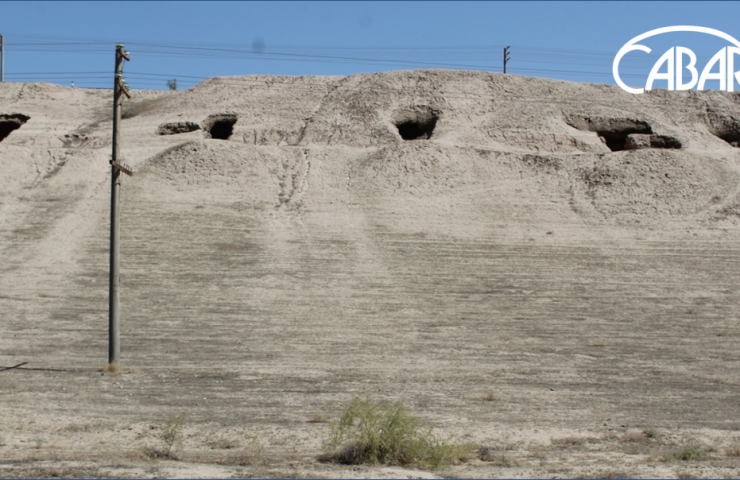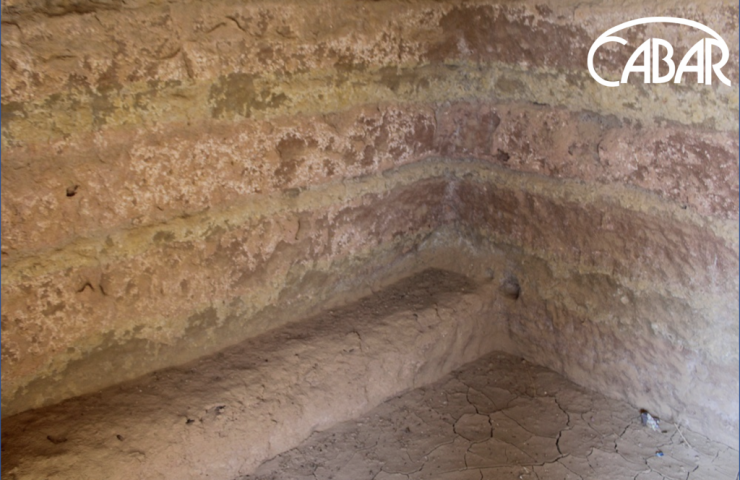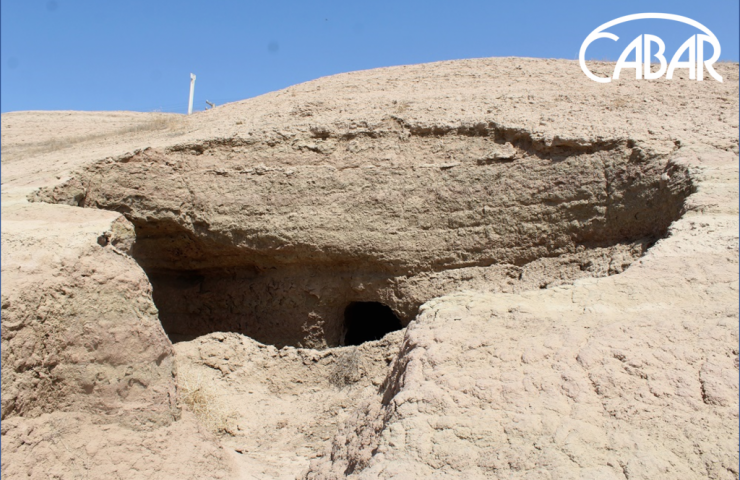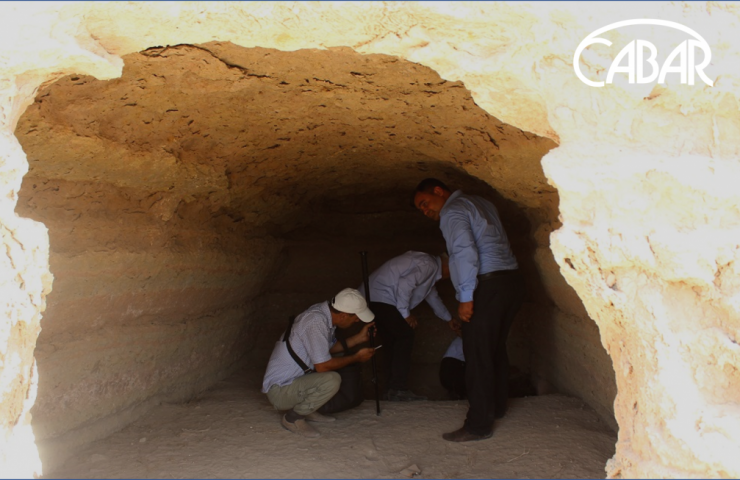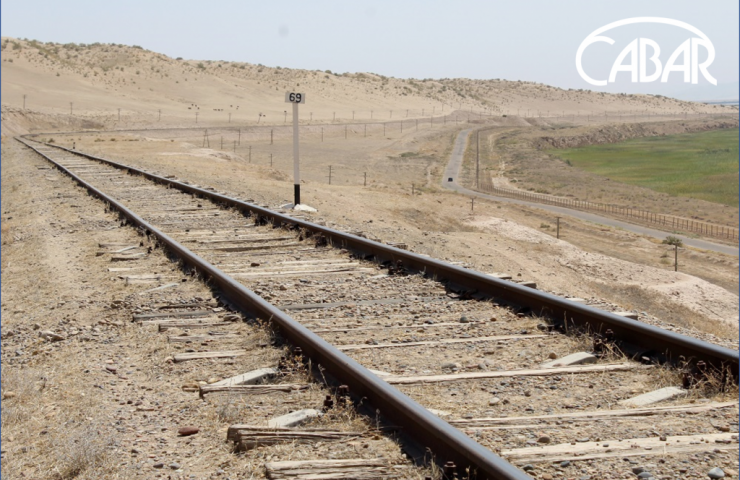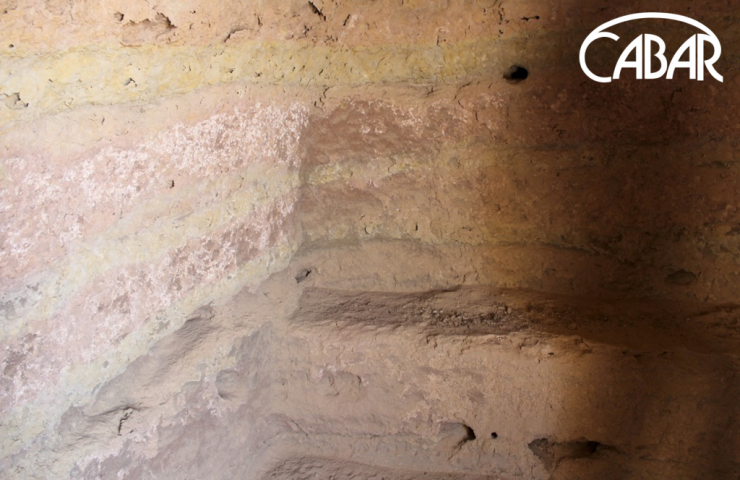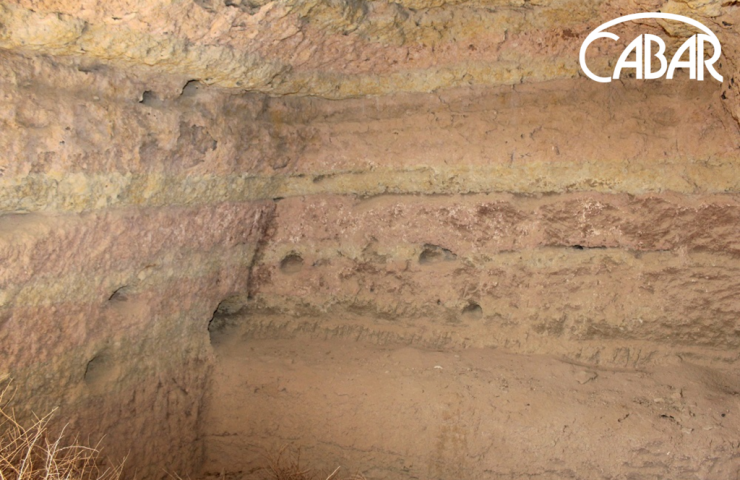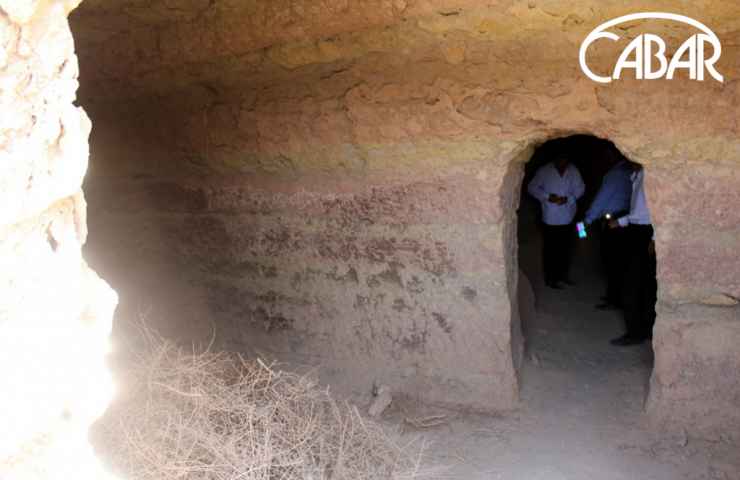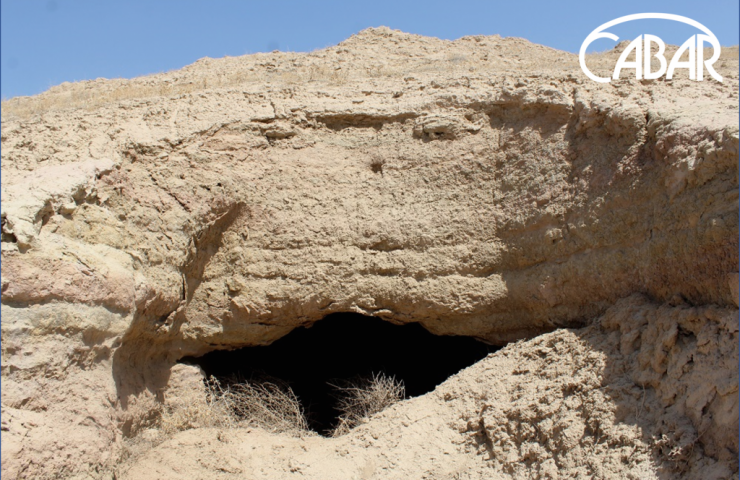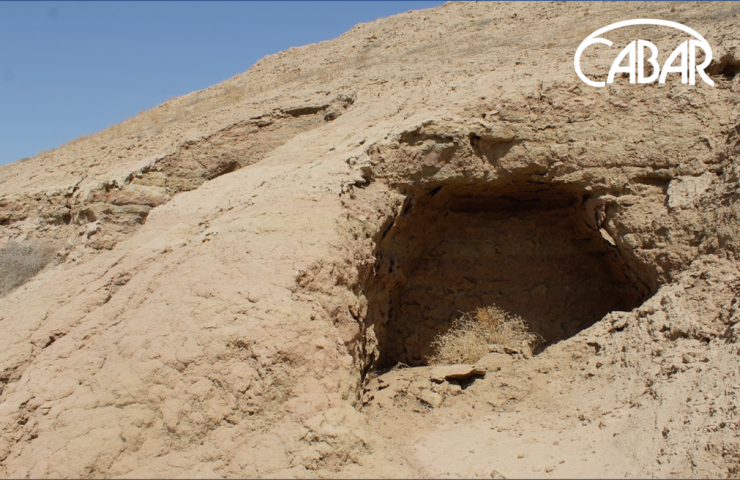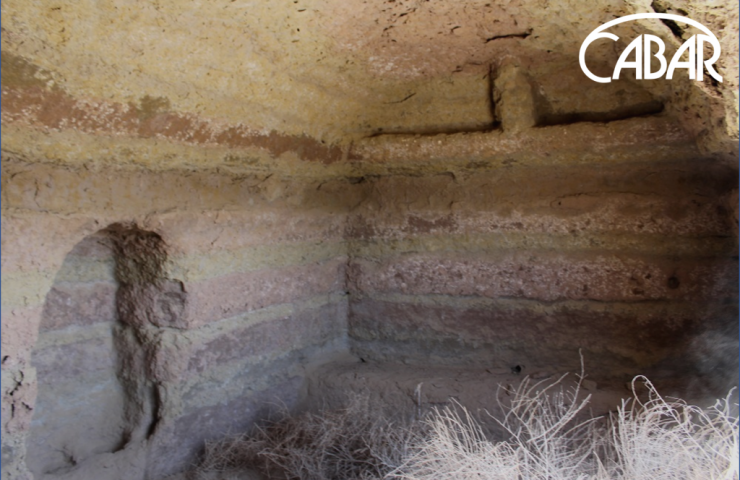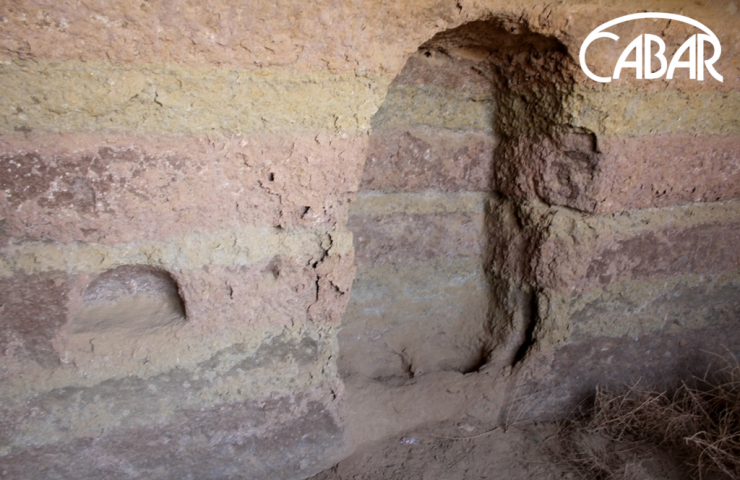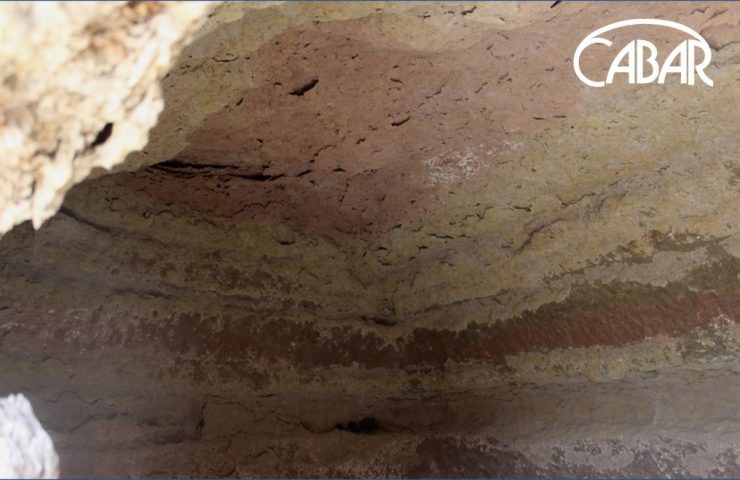The lack of relevant state attention to ancient historical monuments may lead to the loss of Tajikistan’s pre-Islamic history, experts say.
Subscribe to our Facebook page!
In the south of Tajikistan, there is a village called Aivaj. It is located in the Shahritus region, at the junction of the borders dividing Tajikistan, Afghanistan and Uzbekistan. This place is unique for several reasons.

First of all, it is the southernmost point of the country with record high summer temperatures. In addition, as it turned out, there are a series of not yet fully studied ancient and rare historical monuments about 15 km from this village towards the border; the loss of these monuments can lead to the disappearance of a whole layer of Tajik history of the pre-Islamic period.
Our investigation revealed that Tajik historians and archaeologists have not studied these unique caves for a long time. Some local officials are not aware about their historical value, while other local authorities, which know their value, take no measures to preserve them. Their disappearance can take away the secrets of the history of this region.
On the right bank of the Amu Darya, in the upper part of the hills rising at a level of 30-40 meters above the road, one can see 18 caves, similar to monastic cells; they occupy about 100 meters.

The caves are 5 meters apart. Some of them are already largely destroyed and almost razed to the ground. In 1970s, the Amuzang-Bokhtar railway was constructed over these caves; it is still active today. Despite the fact that the caves are subject to pressure from heavy trains, most of them are still quite stable.
These caves contain spacious rooms with square floors and semicircular ceilings. Most of them have one to three rooms. The largest room is approximately 6 by 3 meters. Ceiling height is at least 2 meters. In the rooms, opposite the doors, there are carvings similar to a mihrab (a niche in the wall for prayers). Some rooms have narrow elevations (up to 50 cm) for sitting and sleeping. In the ceiling of two rooms, there are images of crosses, one of which is approximately five meters long. Rows of various holes are carved in the walls.
During our October 2019 trip there, it was empty around the caves, but abandoned plastic bottles and rubbish testified to the fact that there were people here, most likely shepherds. Rare residents are aware of the existence of these caves and call this place Hajdahhona or Hajdahgora (“eighteen rooms” or “eighteen caves”), but do not know anything about their history. This place is located near the border post and access to it is prohibited.
We became interested in the images of crosses on the ceilings of these caves, and we decided to find out what kind of monuments they are and why are there only few of those who know about them.
The only description of the results of archaeological excavations conducted in these places was recorded more than half a century ago. The description is brief and it still gains no special attention from the scientific community of Tajikistan. Moreover, local authorities do not make efforts to preserve and restore these unique architectural caves.
According to the Candidate of Historical Dciences Sherali Khodjaev, Head of the Department for the Protection of Historical Heritage of the Ministry of Culture of Tajikistan, Member of the Council of Analysts of Historical Material and Intangible Historical, Cultural and Natural Heritage of the CIS, this monument was registered in the early 50s of the last century by scientists working at the Institute of History, Archeology and Ethnography named after Ahmad Donish of the Academy of Sciences of Tajikistan (formerly Tajik SSR). He added that the object in question consists not of 18, but of 25 separate caves.
Unfortunately, over the past 50 years, not a single scientific article in Tajik language has been published on Aivaj caves. However, one can find many articles in Russian, Polish, German and English online, which indicates foreign historians’ interest in this object. Most of the articles are based on the 1970s research of a group of archaeologists; these articles have been published in different years.
Disputes: Christianity or Buddhism?
Aivaj caves show signs of religious architecture. In the report on the results of their group’s work “On the Work of the Shaartuz Archaeological Team in 1968-1970”, scientists Khmelnitsky and Atakhanov indicated the religious significance of the memorial.
Scientists and archaeologists disagree on religious affiliation of these caves. Some of them believe it were the ancient Christian monuments discovered in the south of Tajikistan, others believe these caves are Buddhist.
“From the point of view of floor-plan, internal structure and building techniques, the monument in question has no analogues in Central Asian architecture after the Arab, Muslim era. On the contrary, in the architecture of the early pre-Arab Middle Ages in the Middle East, large complexes of artificial caves are well known and are unanimously associated with structures of one specific purpose – monasteries” (p. 199). Describing the found monuments, they provide comparisons. One of them reads: “In our case, the branches of the cross have a trapezoidal shape, sharply expanding from the center to the edges, and in its outline the relief is most similar to the sign of the old Russian Order of St. George” (p. 201).
Aidogdi Kurbanov, author of “The Hephthalites: Archaeological and Historical Analysis” (in Polish), referred to this article and suggested this is a monument of Christianity, probably – of Nestorianism.
Boris Anatolyevich Litvinsky, known as the founder of the scientific school of archeology in Tajikistan, questioned the findings of the authors in the same article: “T. Atakhanov and S. G. Khmelnitsky expressed a different version about the Aivaj caves, regarding their connection with Christianity. The weakness of their arguments: the article does not provide comparisons and evidence arising from an analysis of the sources of religious construction practices of Eastern Christianity” (p. 22-23). Litvinsky, Boris Anatolyevich.
The archaeologists T. Atakhanov and S. G. Khmelnitsky conclude their article: “The final confirmation or refutation of the hypothesis put forward above can only be done after the excavation of the monument and its further in-depth study have been completed” (p. 203, ibid.).
Since the secrets of the unique ancient historical monument were no longer studied, the problem of identification of its religious affiliation remains open.
The Tajik experts have other hypotheses about the belonging of this monument to a particular religion.
This monument has remained from the time of Alexander the Great, – said Turdimurod Ochildiev, a distinguished history teacher, resident of the Shahritus region.
“In the III century BC, Alexander the Great attacked our land, which at that time was called Bactria. The crosses in the caves are very similar to the crosses that were depicted on Christian banners. I doubt the veracity of this version, since there were no crosses on the banners of Alexander. But most likely, these caves remained after the Crusades, war against Islam,” says Khairullo Davlatov, art historian.
Sherali Khodjaev, mentioned this monument as a “Christian shrine” and noted that it relates to the era of BC.
“During the divide in Christianity, the representatives of one of its branches advanced from Syria to Ancient Bactria and settled on the right bank of the Amu Darya River, at an altitude of about 40 meters above the river. These cave rows are characteristic of the clergy of this group of Christians,” he added.
“Judging by the photographs, the signs in the caves resemble the signs and symbols of Buddhism and Christianity,” emphasizes Khushvakt Abdunazarov, Doctor of Historical Sciences, Professor at Bokhtar State University named after N. Khusrav. – “In the Kushan era, in the I-IV centuries BC, Buddhism and Christianity (Greco-Buddhism) came together and a certain mixed culture appeared. This is a Buddhist monument. This religion’s Mahayana branch then came to our areas.”
Another Tajik scientist, Nuriddin Sayfulloev, Head of the Department of Archeology at the Institute of History, Archeology and Ethnography named after Ahmad Donish of the Academy of Sciences of Tajikistan, says: “In order to get the best answer, I looked at your photos together with Chinese scientists. They said that Buddhism of the ancient period also featured symbols similar to the images of the cross, and referred to the Kushan kingdom.”
Aivaj Caves Are Not the Only Ones
Meanwhile, the former head of the ‘Avasto’ Museum of Local History of Khatlon Region Safarmoh Yatimova says that there are two more caves of the type of Aivaj caves; they are located in Panj district, on the banks of Panj River, near the border with Afghanistan. She visited them only once in 2007. She noted that the crosses are also depicted in those caves’ ceiling centers.
“In the village of Fahrobad of the Khuroson district, there is a place called Jarmachit (jar – abyss, machit – mosque). It also features similar caves. And ‘mihrabs’ are also there. After Islam spread in these places, they [caves – Tr.] were converted into mosques. In the Sangvor district (formerly Tavildara) in the east of Tajikistan, there is the burial vault of St. Burkh, and there are similar caves there as well,” H. Abdunazarov said. He also noted that, usually, such caves were located in mountainous areas, on riverbanks.

There are many historical monuments of religious origin in Khatlon region, and, according to our observations, most of them are related specifically to Islam. Of the historical heritage belonging to other religions, the famous “Ajina-teppa” in the Vakhsh region, a Buddhist temple of the 7th century, should be noted. It is one of the most famous architectural monuments and is included in the UNESCO World Heritage Register.
The specialists from the Department of Culture of Khatlon Region claim that there are 931 historical and cultural monuments in the region. 721 of them are archaeological sites, but more than half of them remain completely unexplored. Only 20 have all the necessary certificates.
According to S. Khodjaev, until the 30s of the XX century, from the ancient Khulbuk fortress in Vose district to the city of Kulob, over a total area of 30-35 kilometers, as much as 154 ancient monuments were discovered; however, it is only their ruins that were preserved. Unfortunately, to date, only a very small part of them has been studied.
Lack of Funding
The “State Program for the Protection of Historical and Cultural Heritage for 2012-2020” was adopted to preserve the historical and cultural heritage in Tajikistan. To finance the first phase of the implementation of this program in 2012-2015, 27 million 215 thousand somoni were allocated. At the second stage, for 2016-2020, 40 million 225 thousand somoni. These funds were allocated for rebuilding 25 fortresses, 7 tombs, 5 madrassas, 3 historical mosques and 3 temples of the pre-Islamic period, restoring 17 and rebuilding 11 monuments, keeping maintenance of 8 monuments, partial restoration of 5 monuments and reconstruction of 2 archaeological sites.
However, according to official data taken from the appendix to the letter of the Ministry of Economic Development and Trade of the Republic of Tajikistan, due to insufficient funding, 7 out of 26 action points of the first stage of the above-mentioned program were not implemented.
In the second stage, during 2016-2018, a total of 450 thousand somoni was spent, which is only 7.7% of the envisaged expenses. Of all the local authorities, only the executive body of the Istravshan district of the Sughd region allocated money for the implementation of this program.
We did not manage to find out whether Aivaja caves are included in the lists of objects this State Program covers. However, judging by the fact that this object has only recently been included in the state register (approved by decree of 08/31/2018, No. 356), no one is engaged in the restoration or continuation of research in this area.
Sherali Khodjaev noted that the monument was included in the unified state register of historical monuments of the Shahritus districts recently. He emphasized that its uniqueness lies in the fact that there are no such monuments anywhere else in the region. Nevertheless, unfortunately, due to its geographical location, namely, because it is located on the border between three states, in close proximity to Afghanistan, its restoration and study are currently challenging.
According to him, it is impossible to resume archaeological excavations and carry out restoration of this object until the situation in a neighboring Afghanistan stabilizes.
“No one will undertake to ensure the safety of archaeologists when they begin to work in the immediate vicinity of the border strip,” he said.
However, in our opinion, it is not only security in the border region that contributes to difficulty in working with the site. If desire, the authorities can find funds to restore more famous monuments that belong to Islamic culture and are popular as destination for pilgrimage among the local population.
So, for instance, an Islamic monument was restored in the same Shahritus district in the beginning of 2000s.
According to information published on the website of the US Embassy in Tajikistan, from the Ambassador’s Fund for Cultural Preservation in 2005-2007 and 2009, as part of a special project to reduce the impact of groundwater around the madrassa and mausoleum of Khoja Mashhad, Shahritus district, a total of 121 thousand US dollars was spent to install drainage pipes, strengthen the structures, eliminate structural damage, reconstruct the western part of the building, elements of the main building, main entrance, corner towers, decorative panels and the eastern dome.
We could not obtain other information on whether there were other projects to restore the objects of historical heritage for more than 10 years after the reconstruction of the Khoja Mashhad memorial in the Khatlon region.
Some experts believe that local authorities could make more efforts to preserve monuments in their regions.
Abdunazarov believes that the irresponsibility and inattention on the part of local authorities to the preservation of historical sites contributes to the fact that many valuable archaeological sites may disappear and be lost.
“We should improve the capacity of archaeological excavations in the country and prove to the world that we are a country with an ancient civilization. In accordance with the Law on the preservation of historical monuments, such structures must be protected. The local authorities are obliged to ensure that during the construction of new facilities, when distributing land for various types of use, archaeological sites do not collapse or disappear. Each district should have special maps listing all historical objects. Unfortunately, not all districts have such maps. And when we do not have maps, we cannot even imagine how many objects, the value of which cannot be calculated, have gone underground. To build a store or another object, we demolish everything. But all this is our history and civilization! If all this disappears, there will be many dark spots in our history,” he added.
Even during Soviet times, there were not enough of archaeological excavations in the Khatlon region, says N. Sayfulloev. After the collapse of the Soviet Union, there were very few excavation works going. Moreover, in some areas, such as Panj and Farkhor, they were not conducted at all.
The experts we have talked to – H. Abdunazarov, H. Davlatov and S. Yatimova, proposed a number of measures to preserve the Aivaj historical-architectural monument:
- Cover it with a special dome;
- Reduce the damage from the railroad over the monuments;
- Prepare a protected area project;
- Install preservation signs;
- Resume archaeological excavations;
- Attract leading domestic and foreign experts to resolve the dispute over its religious affiliation;
- Prepare scientific papers and indicate the history of this monument in history textbooks.
“This unique place, of course, can attract many tourists, scientists, historians and archaeologists from all countries. If we provide Western experts and world-renowned scholars an access to study this unique historical object, we will contribute to thorough study of the object and enrich our history. After all, they have all the necessary equipment and funds,” said Professor Khushvakt Abdunazarov.
In accordance with Article 16 of the Law of the Republic of Tajikistan “On Protection and Use of Objects of Historical and Cultural Heritage”, the preservation of historical and cultural heritage sites and their operation is the direct responsibility of authorized state and local authorities, and they are required to inspect and identify their condition once every five years, so that a further work plan and a new state program can be designed. We hope it will not take decades to implement this article to protect, study and restore this historic site.
This journalistic investigation was conducted under IWPR project “Stability in Central Asia via Open Dialogue”.
Bibliography
– On the Work of the Shaartuz Archaeological Team in 1968-1970. S. G. Khmelnitsky, T. M. Atakhanov. In: Archeological Works in Tajikistan, Vol. X (1970), B.A. Litvinsky. Moscow, 1973, pp. 187-204;
– Between Kushans and Arabs. S. G. Khmelnitsky, pp. 250-254, and monography in German language: Zwischen Kuschanen und Araben, pp. 172-175.
– Cave monastery in Aivaj. In: Construction and Ornament, S. G. Khmelnitsky. Moscow, 2013. (https://www.academia.edu/37642660/Хмельницкий_С._Конструкция_и_орнамент.pdf)
– Cults and Rituals of Kushan Bactria. Burial Ritual. B. A. Litvinsky, A. V. Sedov, Moscow, 1984, 240 p. (https://books.google.com.ua/books/about/Культы_и_ритуалы_куша.html?id=CcsitwAACAAJ&redir_esc=y)
–The Hephthalites: Archaeological and Historical Analysis, in Polish and German languages, doctoral thesis. Berlin, 2010.


